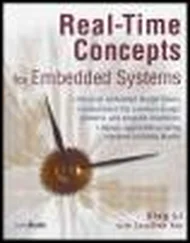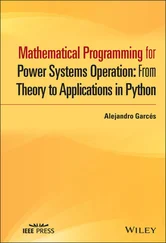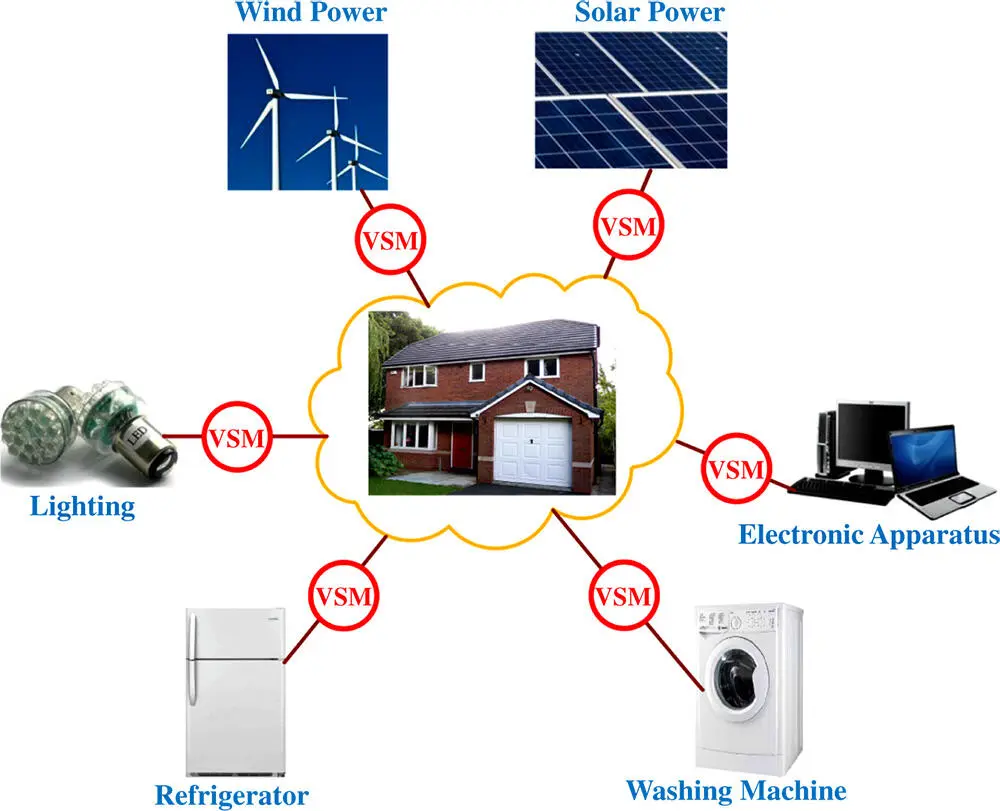
Figure 2.6A SYNDEM home grid.
2.4.3.2 Neighborhood Grid
The home grids in a neighborhood can be connected together to form a neighborhood grid through energy bridges, as illustrated in Figure 2.7. This will allow neighbors to support each other when there is a fault on the public utility grid, providing the highest resiliency to neighborhoods.

Figure 2.7A SYNDEM neighbourhood grid.
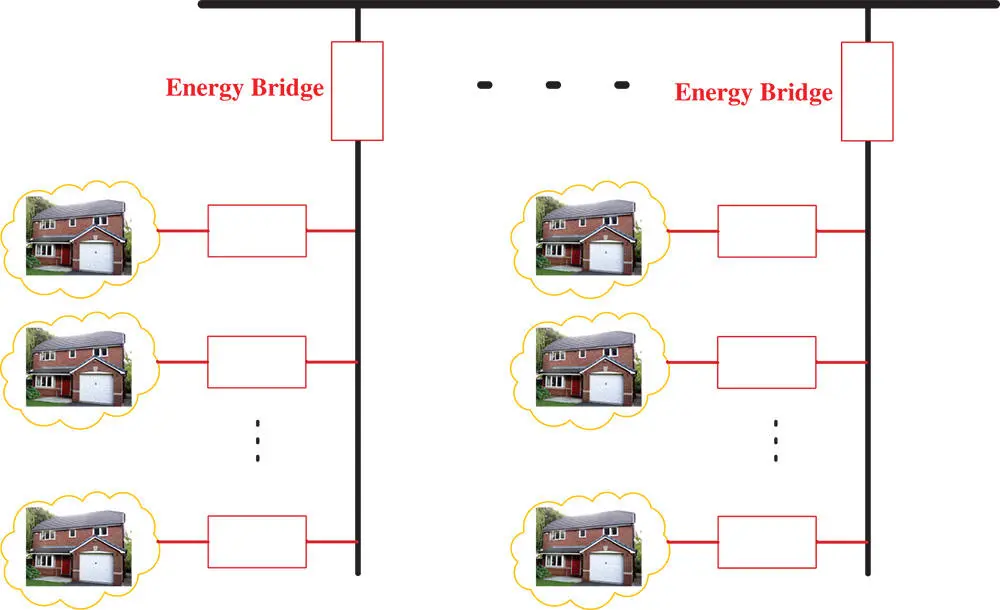
Figure 2.8A SYNDEM community grid.
The neighborhood grids can be connected together to form a community grid through energy bridges, as illustrated in Figure 2.8. These energy bridges often have higher current ratings than the ones used to connect/isolate individual homes. Since an important function of the energy bridge is to isolate a part of the grid when there is a fault without affecting the normal part, this provides the highest resiliency to the community.
The community grids in a district can be connected together to form a district grid through energy bridges, as illustrated in Figure 2.9. These energy bridges often step up the voltage to reduce losses. Again, any part of the grid that is faulty can be isolated and reconnected after removing the fault, providing the highest resiliency.
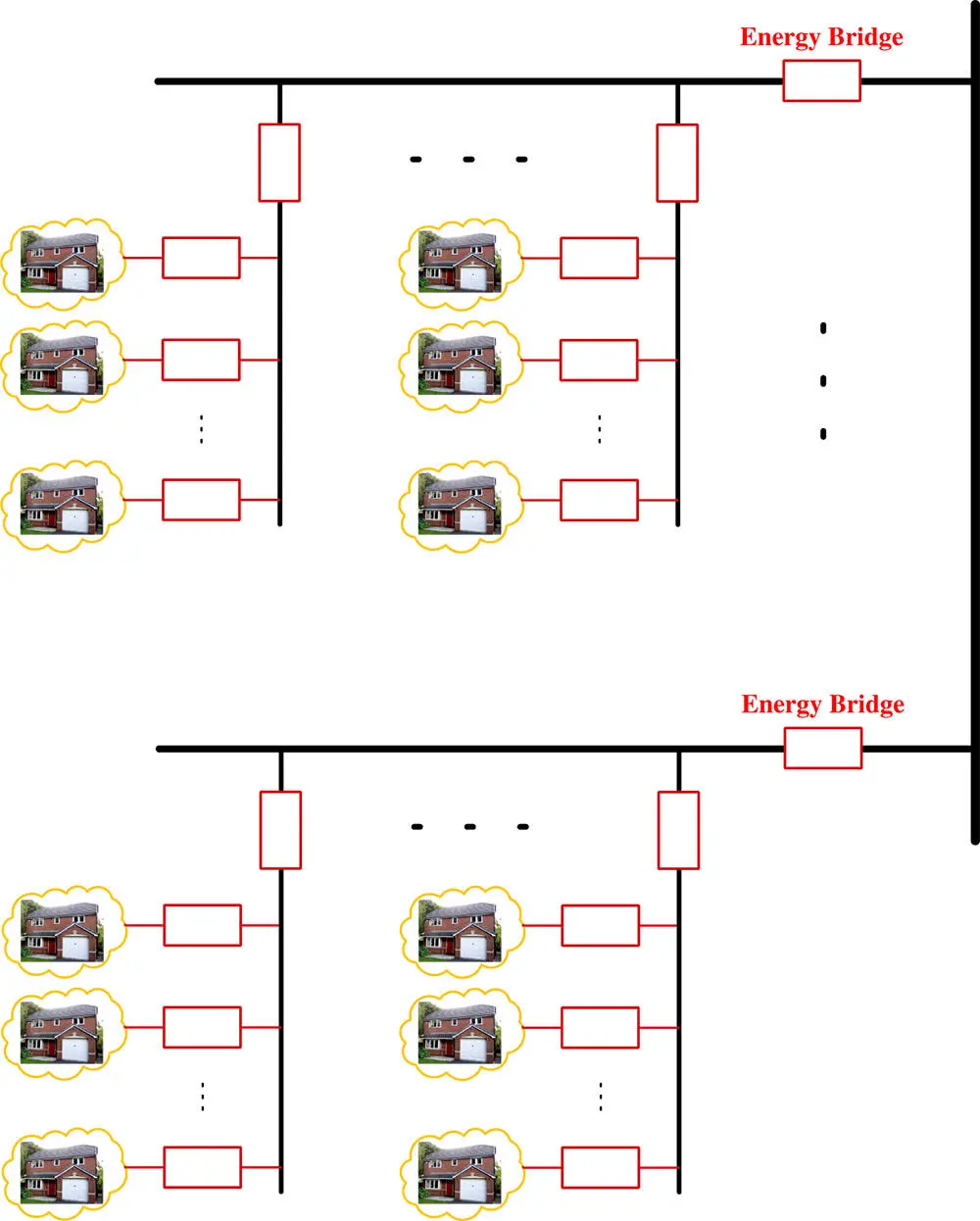
Figure 2.9A SYNDEM district grid.
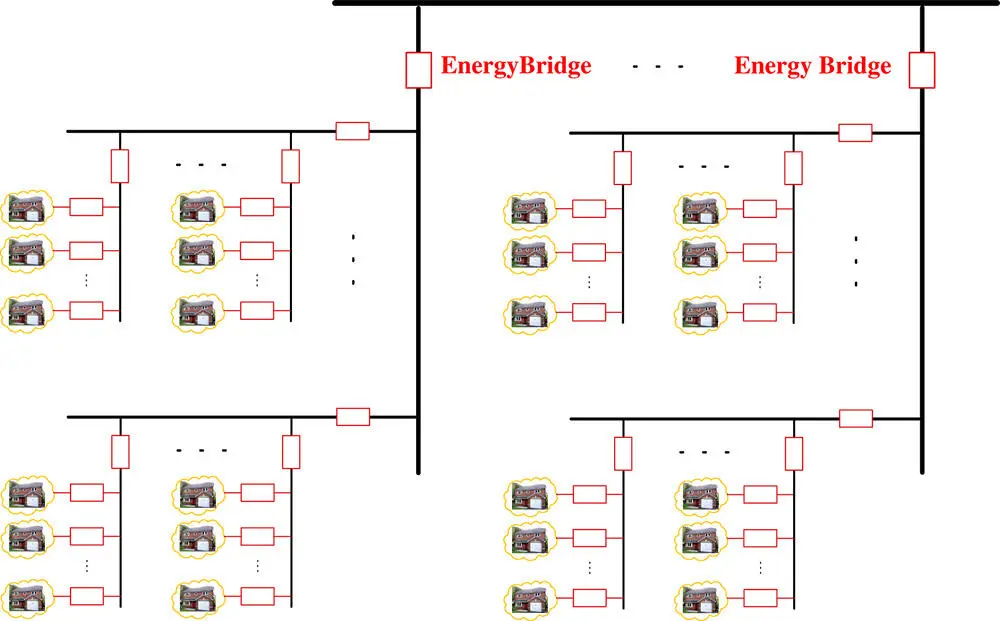
Figure 2.10A SYNDEM regional grid.
The district grids in a region can be connected together to form a regional grid through energy bridges, as illustrated in Figure 2.10. These energy bridges often step up the voltage further. Again, any part of the grid that is faulty can be isolated and reconnected after clearing the fault, providing the highest resiliency.
All the SMs and VSMs have the same intrinsic mechanism of synchronization so there is no need to rely on ICT systems to achieve low‐level control. In other words, ICT systems can be released from low‐level control to focus on high‐level functions of power systems, e.g. SCADA and market operations (Wu et al. 2005), significantly reducing the investment in the ICT infrastructure. This also helps enhance the cyber security of the system because reduced or even no access to low‐level controllers is provided to malicious attackers, significantly reducing the investment in cyber security and eliminates a systemic flaw for power systems with regarding to cyber security.
The SYNDEM architecture turns all loads with a power electronic converter at the front end into active and responsible players to maintain system stability and achieves a continuous demand response. This prevents critical customers from suffering complete loss of electricity. Instead, all such loads make a small, often negligible, amount of contributions. This improves quality of service (QoS) and prevents local faults from cascading into wide‐area blackouts, correcting another systemic flaw of power systems. Because the synchronization mechanism of synchronous machines is the key principle that has underpinned the growth and operation of power systems for over 100 years, the transition from today's grid into tomorrow's SYNDEM grid is evolutionary rather than revolutionary.
The SYNDEM grid architecture is scalable and can be applied to power systems at different scales, from single‐node systems to million‐node systems, from vehicles and aircraft to public grids. When there is a need, small systems can be connected together. When a part of the grid is faulty, it can be disconnected; after the fault is cleared, it can be re‐connected. If HVDC links are used to link AC systems at different frequencies, then the AC systems can be operated together or, if needed, independently. Hence, while the architecture allows small grids to merge and form large‐scale power grids, it also naturally allows large grids to break into small ones. Hence, this may offer the technical foundation to turn a move in China that broke up the Chinese Southern AC grid (Fairley 2016) into a natural trend worldwide.
The deployment of SYNDEM grids could considerably reduce infrastructure investment in generation, transmission and distribution networks. Take the UK power grid that has the capacity of about 70 GW as an example. If all loads contribute 2% in a contingency, which is within the tolerance for most individual loads, then the total contribution from all loads is about 1.4 GW. This is higher than the capacity of any current UK nuclear power plants, which means the UK grid is able to cope with the trip‐off of any nuclear power plant if all loads consumes 2% less electricity. The architecture also allows all inertia that already exists in the system, e.g., those in wind turbines, large industrial motors and electric vehicles, to be released, which helps considerably reduce the operational cost because of the fast reaction of power electronic converters. For example, if there are 10 million laptops plugged in a grid and each contributes 10 W when needed, then the equivalent reserve amounts to 100 MW, which is at the level of power generated by 50 wind turbines rated at 2 MW.
Because of the intrinsic synchronization mechanism embedded into each VSM, it is less likely for a VSM to disconnect from the grid under grid variations. This will increase the uptime of renewable generators and hence the yield, bringing more revenue to the owner.
2.6 Brief Description of Technical Routes
2.6.1 The First‐Generation (1G) VSM
Different options to implement VSMs are available in the literature. The VISMA approach (Beck and Hesse 2007; Chen et al. 2011) controls the inverter current to follow the current reference generated according to the mathematical model of synchronous machines, which makes inverters behave like controlled current sources. Since power systems are dominated by voltage sources, this may bring detrimental impact, in particular on system stability (Dong et al. 2013; Sun 2011; Wen et al. 2015). The approach proposed in (Gao and Iravani 2008) follows the mathematical model of SMs but it requires the measurement of the grid frequency, which is often problematic in practice (Dong et al. 2015). The approach proposed in (Karimi‐Ghartemani 2015) controls the voltage but it also requires the measurement of the grid frequency for the real power frequency droop control. The synchronverter approach (Zhong and Weiss 2009, 2011; Zhong et al. 2014) directly embeds the mathematical model of synchronous machines into the controller to control the voltage generated, even without the need for measuring the grid frequency or a phase‐locked loop (Zhong et al. 2014). The synchronverter has been further developed for microgrids (Ashabani and Mohamed 2012), HVDC applications (Aouini et al. 2016; Dong et al. 2016), STATCOM (Nguyen et al. 2012), PV inverters (Ming and Zhong 2014), wind power (Zhong et al. 2015), motor drives (Zhong 2013a), and rectifiers (Ma et al. 2012; Zhong et al. 2012b). The synchronverter technology offers a promising technical route to implement SYNDEM smart grids and is described in detail in Part II. Because it offers a basic and conceptual implementation of VSMs, it is classified as the first‐generation (1G) VSM.
Читать дальше






